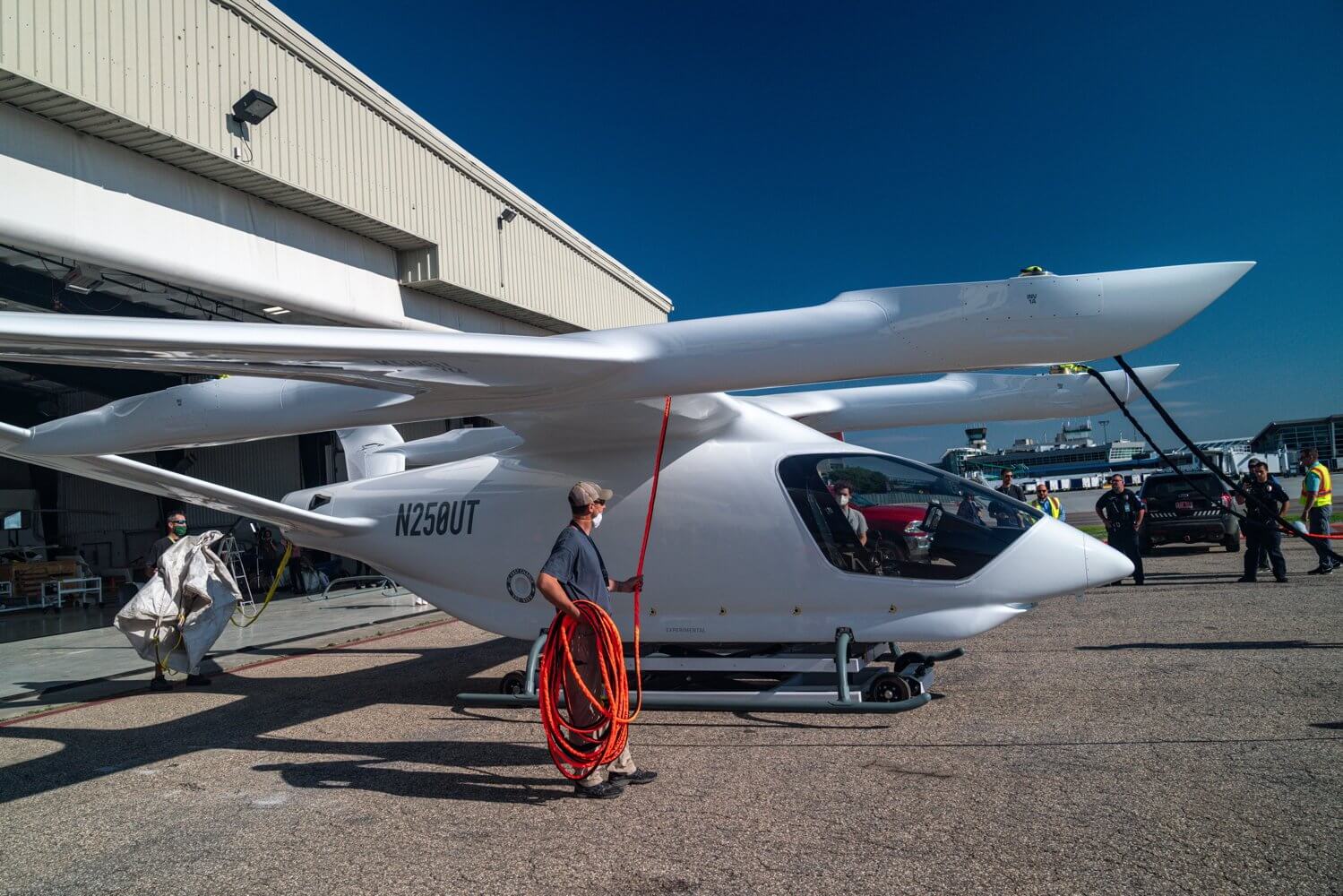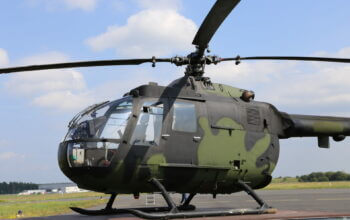On Friday, June 12, Burlington, Vermont-based electric aviation startup Beta Technologies revealed its striking new aircraft, an all-white electric vertical take-off and landing (eVTOL) beauty code-named Alia. The mechanism for the debut was a leisurely — if not downright balletic — helicopter airlift across Lake Champlain to its official testing ground, a former Air Force base in Plattsburgh, New York.

The roughly 30-minute operation saw the sleek, four-rotor airplane — one of the anticipated front-runners in the global race to launch a viable, fully electric VTOL aircraft — suspended 100 feet below a massive Sikorsky S-61N operated by Quebec-based lift specialist Helicarrier. The pair crossed over the northern end of Burlington, with streets along its route blocked off by police, then flew at a stately pace across the lake, usually just a few hundred feet above the surface of the water.
Helicarrier makes quick work of even the most challenging lifts, from refrigeration units in dicey urban environments to industrial machinery. If it’s under 10,000 pounds (4,535 kilograms) and can be attached to a long line, the company will move it for you. But Alia is a different kettle of fish. For starters, it’s a priceless prototype. Being forced to activate the emergency release and dump it in the lake if something went wrong — something Helicarrier has never had to do — would set the program back at least a year.
“For the most part, what we do typically encompasses things like water buckets on fires or salvage recovery of other crashed airplanes,” said pilot Aaron Lighter, who flew the mission with spotter Fred Carrier, the co-owner and president of the company. “It’s not very often we fly brand-new, experimental, multimillion-dollar projects like this. So, yeah, this is outside our scope a little bit. But at the end of the day it’s a piece of equipment on the end of a long line, and we are very capable of getting it there safely.”
Helicarrier’s load experts and Beta’s engineers collaborated closely in the weeks and months leading up to the airlift to ensure the aerodynamically fine-tuned Alia wouldn’t get a mind of her own in transit. That was unlikely, of course, given that Alia’s stall speed is 90 knots, and the airlift would be well below that at 40 knots, but still, the 6,000-lb. (2,720-kg) maximum take-off weight airplane was stripped down to just over 3,000 lb. (1,360 kg), so it had the potential to float a bit if a good gust of wind caught its wide 50-foot (15-meter) wings just so. Add in other aerodynamic qualities designed into the innovative bird, and a simple slow crawl across a lake on a sunny day could become anything but.

To prepare, engineers removed the four hover motors on the airplane’s two outriggers and replaced them with anchor hooks to which the ropes would be attached. Some batteries remained on board to ensure that the fly-by-wire control surfaces could be positioned to help spoil the airplane’s lift. Personnel also removed the pusher motor, which powers horizontal flight, and put tape over the window seams to ensure the Velcro-affixed canopy — something that makes it easily accessible during testing — would stay in place. Finally, the teams ensured the aircraft had a slight, three-degree nose-down attitude when suspended, and they installed a drag chute in the rear of the aircraft to help it remain stable in the wind, allowing it to weathervane as necessary without spinning out of control.
Helicarrier’s rigging included four cables from the airplane’s outriggers up to a single cable that extended to the bottom of the S-61. The distance from the helicopter to Alia was 100 feet (30 meters). According to Beta test pilot Nick Warren, the lift altitude itself was set at also 100 feet off the ground to ensure that if anything went wrong over land, the crew would have the best chance of settling the airplane by quickly lowering it to the ground. “If you’re up at 3,000 feet, that’s a long way to come down if something starts acting funny,” he said. “There’s nothing that the extra altitude buys them — it just adds extra time on the hook.”

Though the flight itself would be just a quick hop, the build-up was anything but. Beta had to coordinate with local authorities to block traffic on streets and bicycling paths, ensure all the logistics were in place at both the launch and destination airports, and navigate the rules and regulations of the Federal Aviation Administration (FAA). Though the FAA was closely involved in the planning, a variety of last-minute concerns on its part led to several delays in the weeks leading up to the move.
The green light finally came from the FAA and the operations personnel at Burlington International Airport (BTV), where Beta is based, in the middle of last week. The flight was scheduled for Friday, with a 9:30 a.m. liftoff. That placed it just after rush-hour — though many are still in full work-from-home mode — so traffic was light. Weather proved to be spectacular, and dozens of employees at Beta gathered at the hangar and on top of the eVTOL charging station prototype the company built, which has its own top-mounted landing pad, to watch the liftoff. Meanwhile, on the other side of Lake Champlain at Plattsburgh International Airport (PBG), more personnel had gathered to watch the arrival then move the aircraft into its new hangar.
Lighter and Carrier set the S-61 down adjacent to Alia, and ground crews attached the ropes to the hook on the bottom of the Sikorsky. Lift-off went smoothly and Lighter headed northeast from the airport, quickly intersecting with the Winooski River, the path of which Lighter followed to the lake. Two Beta helicopters, flying both chase and photo, met it there, just outside BTV airspace, and escorted the flight across the water.

Fortunately, everything went off without a hitch, and Lighter set Alia down on the spacious, ex-Air Force Base ramp near Beta’s hangar. Within minutes the pair were unhooked, and Lighter took off to pick up personnel back at BTV, then head home. Both Helicarrier and the FAA were pleased with the lift, as was Beta. Its new aircraft landed safe and sound and can now commence flight test in earnest.
Read more about Alia on Vertical’s sister publication, eVTOL.com.










Awesome and Revolutionary all electric aircraftt. I would love take a ride in it and invest in this company.